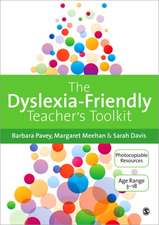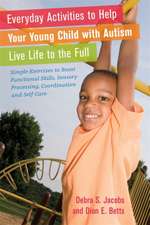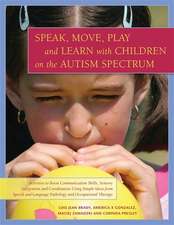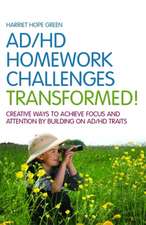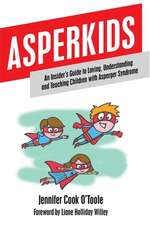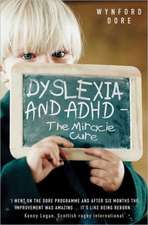Teaching Literacy to Students With Significant Disabilities: Strategies for the K-12 Inclusive Classroom
Editat de June E. Downingen Limba Engleză Paperback – 11 mai 2005
- literary activities;
- parental involvement;
- pre- and post-assessment;
- IEPs;
- peer support;
- school-wide approaches;
- evaluation and grading;
- goal-setting.
The project also includes very practitioner-oriented pedagogy, including Frequently Asked Questions, chapter by chapter references, bibliography with short summaries, and relevant websites.
June Downing is a Professor at California State University, Northridge, where she prepares teachers to work in the area of moderate/severe disabilities. She has been the project director of numerous federally-funded projects to train teachers. For the past 16 years, her focus in teacher preparation has been in the area of inclusive education.
After receiving her BA in Sociology from the University of Colorado in Boulder, Dr. Downing went on to pursue her training at the University of Northern Colorado where she earned an MA in special education with an emphasis in visual impairments. Her Ph.D. in special education with an emphasis in severe and multiple disabilities, including sensory impairments, is from the University of Arizona.
She is currently on the editorial board of The Journal of the Association for Persons with Severe Handicaps and Augmentative and Alternative Communication and has published numerous articles, monographs, training modules, and book chapters in her areas of expertise.
| Toate formatele și edițiile | Preț | Express |
|---|---|---|
| Paperback (1) | 282.83 lei 6-8 săpt. | |
| SAGE Publications – 11 mai 2005 | 282.83 lei 6-8 săpt. | |
| Hardback (1) | 522.01 lei 6-8 săpt. | |
| SAGE Publications – 11 mai 2005 | 522.01 lei 6-8 săpt. |
Preț: 282.83 lei
Nou
Puncte Express: 424
Preț estimativ în valută:
54.13€ • 56.44$ • 44.98£
54.13€ • 56.44$ • 44.98£
Carte tipărită la comandă
Livrare economică 20 martie-03 aprilie
Preluare comenzi: 021 569.72.76
Specificații
ISBN-13: 9780761988793
ISBN-10: 0761988793
Pagini: 192
Dimensiuni: 178 x 254 x 13 mm
Greutate: 0.41 kg
Ediția:New.
Editura: SAGE Publications
Colecția Corwin
Locul publicării:Thousand Oaks, United States
ISBN-10: 0761988793
Pagini: 192
Dimensiuni: 178 x 254 x 13 mm
Greutate: 0.41 kg
Ediția:New.
Editura: SAGE Publications
Colecția Corwin
Locul publicării:Thousand Oaks, United States
Recenzii
“Literacy is power—power to control your own life and influence the world around you. This book makes an important contribution. June Downing has challenged our assumptions about and expectations for students with significant disabilities.”
Cuprins
Foreword - Douglas Fisher
Acknowledgments
Introduction
About the Author
1. Literacy and a Free Appropriate Public Education
Key Concepts
What Is Literacy?
Literacy and Federal Mandates in Education
Barriers to Literacy Instruction for Students With Significant Disabilities
Attitudinal Barrier
Low Expectations
Limited Opportunities
Limited Means of Accessing Literacy
Limited Time
The Age Factor
Literacy and Quality of Life Issues
Self-Esteem
Self-Determination
Independence
Information Gathering
Organization
Learning
Entertainment
Why Teach Reading to Students With Severe Disabilities?
2. Literacy and Communication
Key Concepts
The Relationship Between Communication and Literacy
Building Relationships
Reading Together
The Benefits of Play Interactions
Emergent Literacy for Students of All Ages
Augmentative and Alternative Communication Devices
Building Shared Experiences for Literacy Development
Documentation of Shared Experiences
Drawings
Photograph Books
Tactile Books
Summary
Frequently Asked Questions
3. Planning Literacy Activities
Key Concepts
General Considerations
Literacy Rich Environments
Benefits of Learning in a General Education Classroom
Access to the Core Curriculum
Not Just Physical Presence
Identifying Literacy Goals
What Are the Literacy Goals of the Individual and the Family?
Determining Present Literacy Skills
Analyzing the Environment and the Need for Literacy Skills
Identifying When Literacy Skills Can be Taught Throughout the Day
Creating Literacy-Learning Opportunities for All Ages
Integrated Related Services
Developing Literacy Materials for Individual Students
Age Appropriateness
Individual Consuderations
Physical Considerations
Visual Considerations
Cultural Considerations
Interesting Material
High Quality
Assistive Technology
Computer Access
Summary
Frequently Asked Questions
4. Teaching Literacy Skills
Key Concepts
Concerns With Some Past Practices
General Considerations When Teaching Literacy Skills
Offering Choices
Following Interest Level
Providing Opportunities
Make Accessible
On the Spot Accommodations
Meaningful Literacy Experiences
The Use of a Daily Planner
Within Task Directions
Self-Monitoring Checklists
Language Experience Stories
Interactive and Fun
Clear Literacy Goals in Mind
Drawing Attention to Conventional Literacy
Balanced Literacy Approach
Specific Instructional Strategies
Draw Attention to the Stimulus and Shape the Response
Model the Behaviors of Reading and Writing
Check for Comprehension
Wait for a Response
Provide Corrective Feedback and Praise
Fade Instructional Support
Teaching Generalization of Skills
Summary
Frequently Asked Questions
5. Evaluating Progress: Next Steps
Key Concepts
Alternative Assessments
Interview
Observations
Review of Past Records
The Link to IEP Goals and State Standards
Adapting State Standards on Literacy
Developing Appropriate IEP Goals and Objectives
Passive Versus Active IEP Goals and Objectives
Standard Linked IEP Objectives
Procedures for Measuring Student Progress
Data Collection
Easy to Use Forms
Portfolio Assessment
Using Data for Instructional Purposed
Determining Next Steps
Review Literacy Goals
Raise Expectations
What Are the Logical Next Steps?
Summary
6. The Future for Literacy Access and Instruction
Key Concepts
Improved Strategies to Support Literacy Goals
Strengthening Early Intervention Services
Future Advances in Technology
Bridging the Research-to-Practice Gap
Impact on Personnel Preparation
Impact on Quality of Life
Resources
Glossary
References
List of Tables
List of Figures
Index
Acknowledgments
Introduction
About the Author
1. Literacy and a Free Appropriate Public Education
Key Concepts
What Is Literacy?
Literacy and Federal Mandates in Education
Barriers to Literacy Instruction for Students With Significant Disabilities
Attitudinal Barrier
Low Expectations
Limited Opportunities
Limited Means of Accessing Literacy
Limited Time
The Age Factor
Literacy and Quality of Life Issues
Self-Esteem
Self-Determination
Independence
Information Gathering
Organization
Learning
Entertainment
Why Teach Reading to Students With Severe Disabilities?
2. Literacy and Communication
Key Concepts
The Relationship Between Communication and Literacy
Building Relationships
Reading Together
The Benefits of Play Interactions
Emergent Literacy for Students of All Ages
Augmentative and Alternative Communication Devices
Building Shared Experiences for Literacy Development
Documentation of Shared Experiences
Drawings
Photograph Books
Tactile Books
Summary
Frequently Asked Questions
3. Planning Literacy Activities
Key Concepts
General Considerations
Literacy Rich Environments
Benefits of Learning in a General Education Classroom
Access to the Core Curriculum
Not Just Physical Presence
Identifying Literacy Goals
What Are the Literacy Goals of the Individual and the Family?
Determining Present Literacy Skills
Analyzing the Environment and the Need for Literacy Skills
Identifying When Literacy Skills Can be Taught Throughout the Day
Creating Literacy-Learning Opportunities for All Ages
Integrated Related Services
Developing Literacy Materials for Individual Students
Age Appropriateness
Individual Consuderations
Physical Considerations
Visual Considerations
Cultural Considerations
Interesting Material
High Quality
Assistive Technology
Computer Access
Summary
Frequently Asked Questions
4. Teaching Literacy Skills
Key Concepts
Concerns With Some Past Practices
General Considerations When Teaching Literacy Skills
Offering Choices
Following Interest Level
Providing Opportunities
Make Accessible
On the Spot Accommodations
Meaningful Literacy Experiences
The Use of a Daily Planner
Within Task Directions
Self-Monitoring Checklists
Language Experience Stories
Interactive and Fun
Clear Literacy Goals in Mind
Drawing Attention to Conventional Literacy
Balanced Literacy Approach
Specific Instructional Strategies
Draw Attention to the Stimulus and Shape the Response
Model the Behaviors of Reading and Writing
Check for Comprehension
Wait for a Response
Provide Corrective Feedback and Praise
Fade Instructional Support
Teaching Generalization of Skills
Summary
Frequently Asked Questions
5. Evaluating Progress: Next Steps
Key Concepts
Alternative Assessments
Interview
Observations
Review of Past Records
The Link to IEP Goals and State Standards
Adapting State Standards on Literacy
Developing Appropriate IEP Goals and Objectives
Passive Versus Active IEP Goals and Objectives
Standard Linked IEP Objectives
Procedures for Measuring Student Progress
Data Collection
Easy to Use Forms
Portfolio Assessment
Using Data for Instructional Purposed
Determining Next Steps
Review Literacy Goals
Raise Expectations
What Are the Logical Next Steps?
Summary
6. The Future for Literacy Access and Instruction
Key Concepts
Improved Strategies to Support Literacy Goals
Strengthening Early Intervention Services
Future Advances in Technology
Bridging the Research-to-Practice Gap
Impact on Personnel Preparation
Impact on Quality of Life
Resources
Glossary
References
List of Tables
List of Figures
Index
Descriere
Break down the barriers to successful literacy instruction and empower students with special needs with these insightful tips, tools, and examples.



